Abstract
Prolactin has been measured in unextracted human plasma by a sensitive and specific in vitro bioassay. Secretory activity of breast tissue fragments from mid-pregnant mice, incubated in organ culture with human plasma, serves as the histologic end point. Sensitivity is 5 ng/ml (0.14 mU/ml) or somewhat better for ovine prolactin, and approximately 0.42 mU/ml for prolactin activity of human plasma at the dilutions used in the assay. Human growth hormone as it circulates in blood, like the material extracted from pituitary glands, is strongly lactogenic. Antisera to human growth hormone are capable of completely neutralizing the prolactin effect of large amounts (600 ng/ml) of human growth hormone added to the system. Plasma prolactin activity is less than 0.42 mU/ml in normal men and women. Of 26 patients with nonpuerperal galactorrhea, 14 had elevated prolactin activities ranging from 0.42 to 3.5 mU/ml. Growth hormone levels by radioimmunoassay were far too low, in general, to account for the observed prolactin activity. All of 14 nursing mothers, 1-30 days post partum, had elevated prolactin activity with a mean of 2.29 and a total range of 0.56-4.5 mU/ml. Growth hormone was in the low normal range in all of these subjects. Seven patients on psychoactive drugs of the phenothiazine series similarly had elevated prolactin activity with low growth hormone. Antiserum to human growth hormone, when preincubated with plasma samples from each of these three groups of subjects, produced no significant inhibition of prolactin activity. In two acromegalic patients with markedly elevated growth hormone levels, antiserum to growth hormone produced complete inhibition of prolactin activity in one and partial inhibition in the other. These studies indicate that human growth hormone and human prolactin are separate molecules, with little if any immunologic cross-reactivity, at least as demonstrated by the antisera used in this study, and that their release is governed by different physiologic mechanisms.
Full text
PDF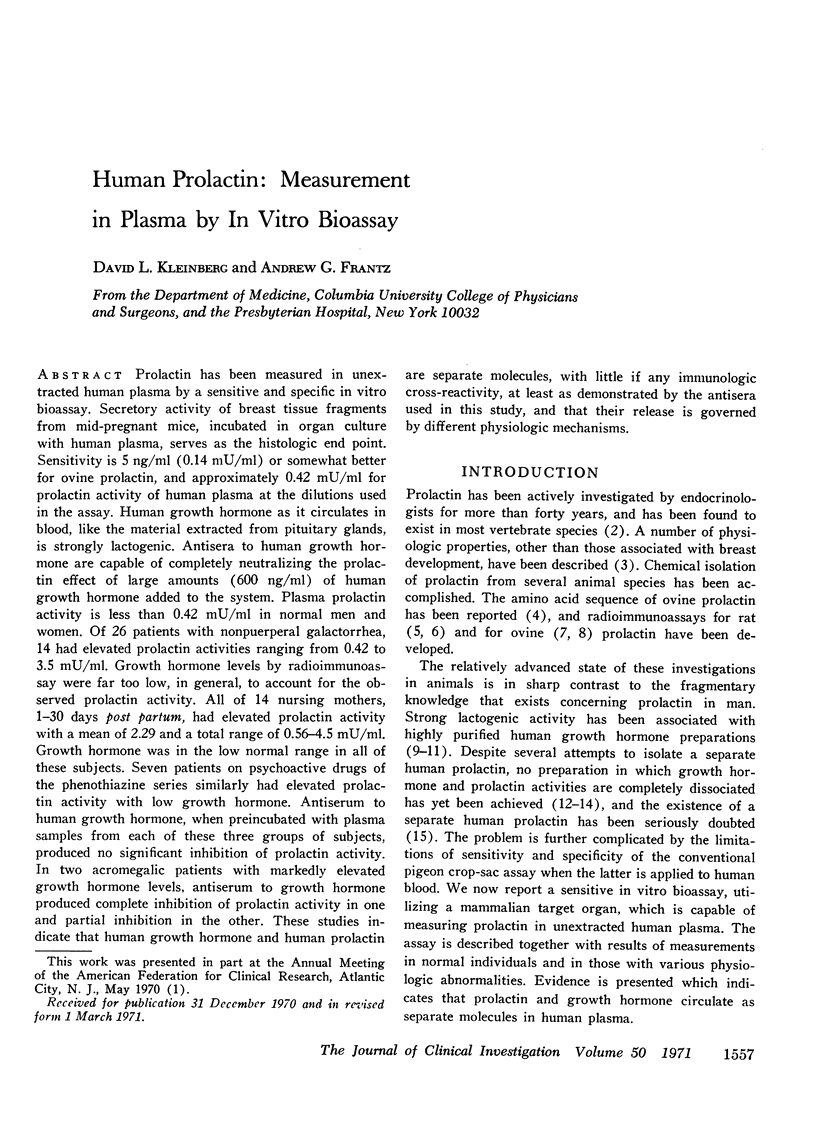
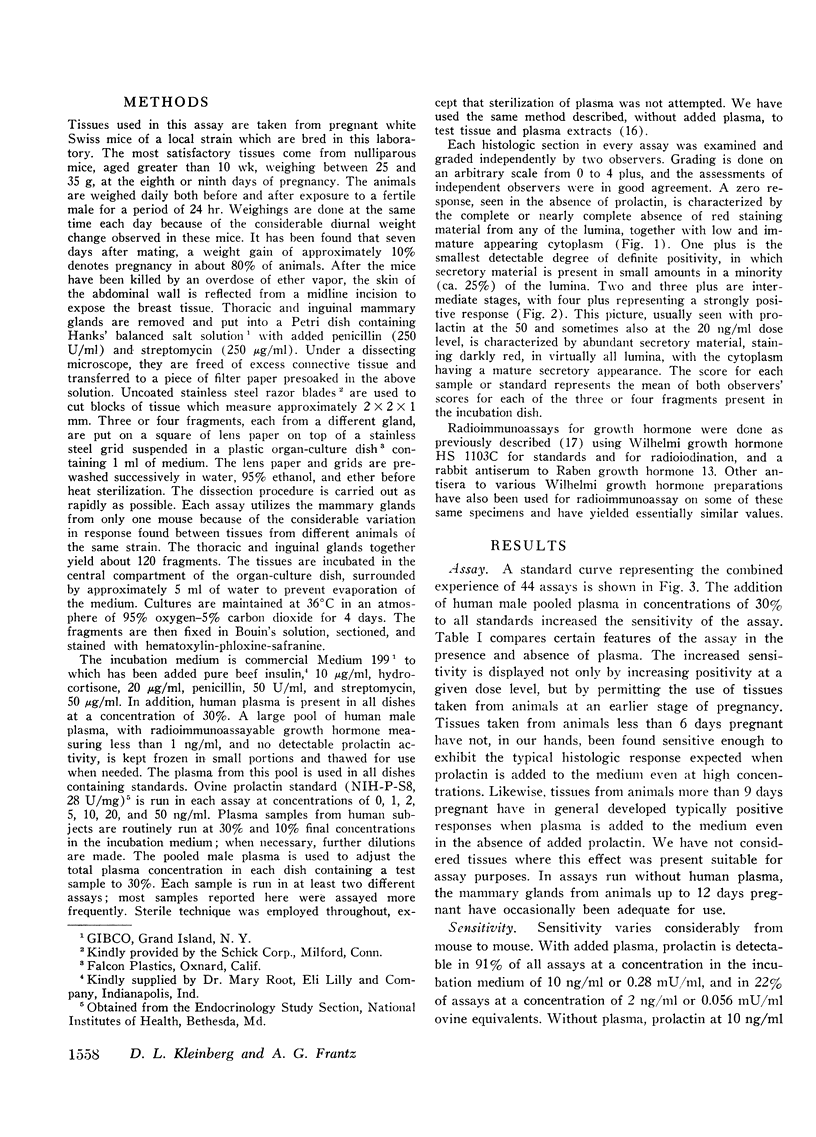
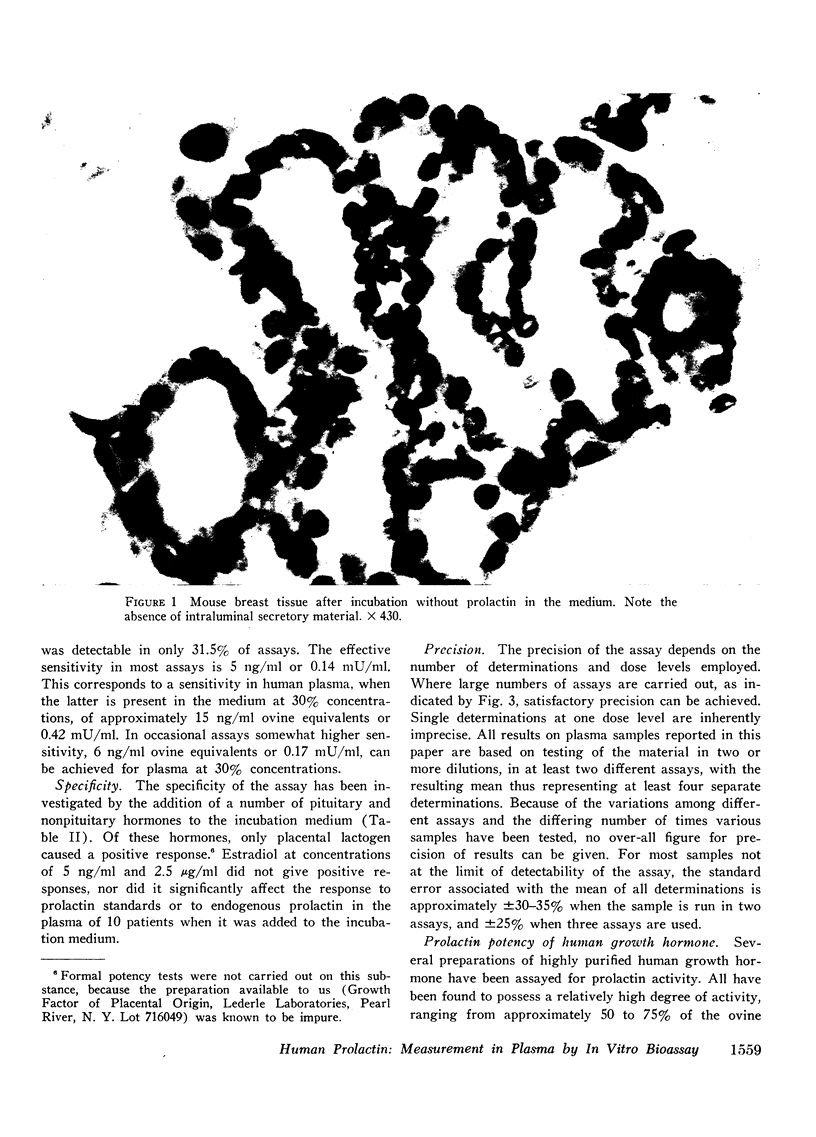
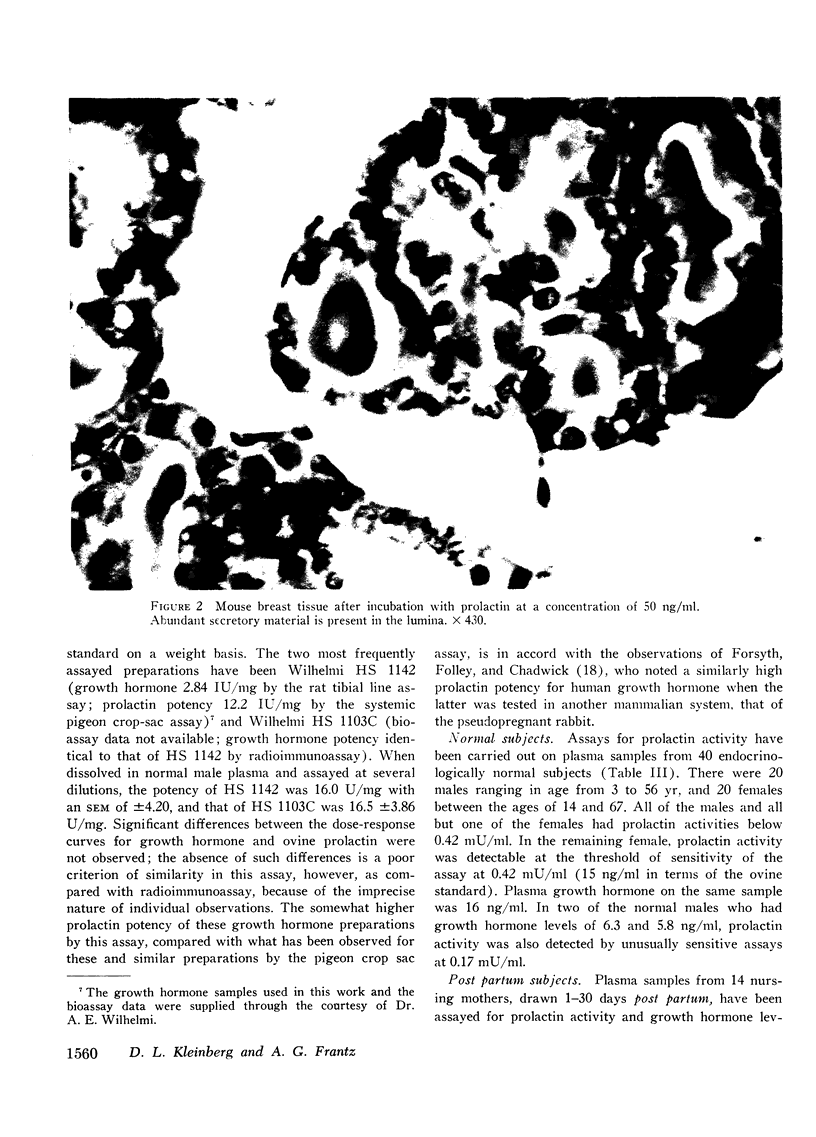
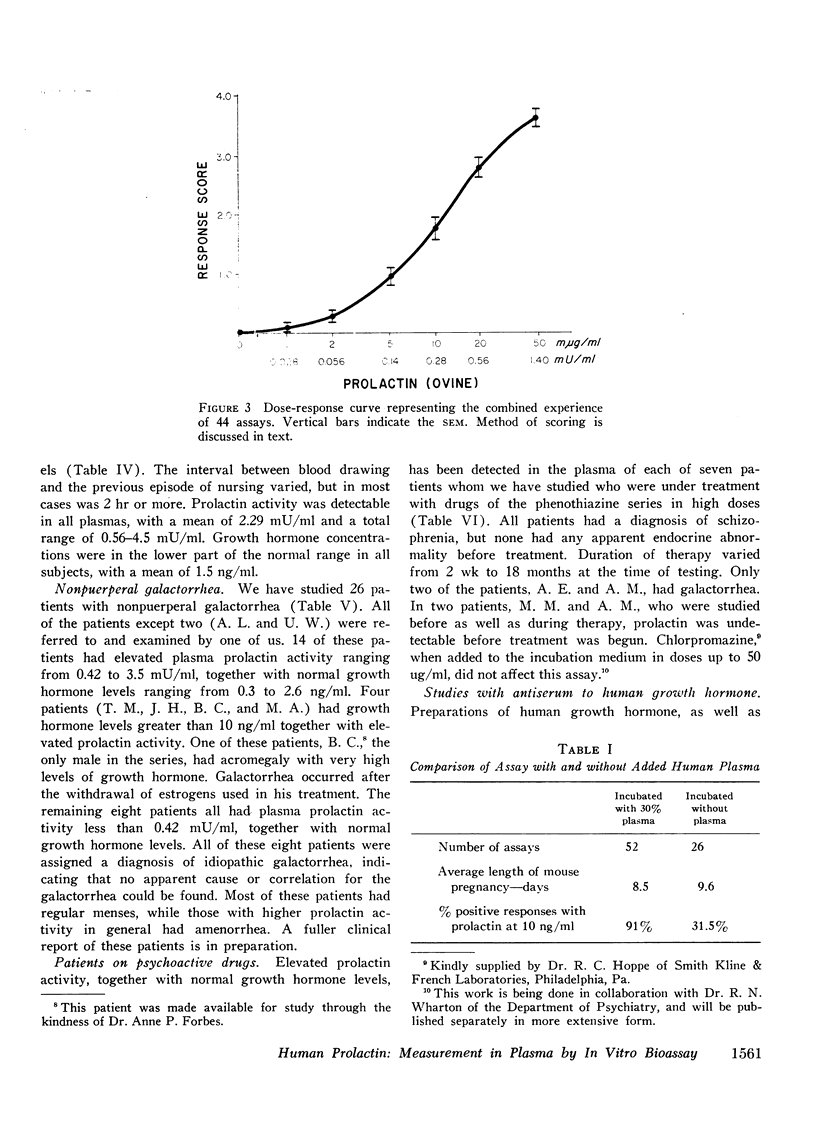
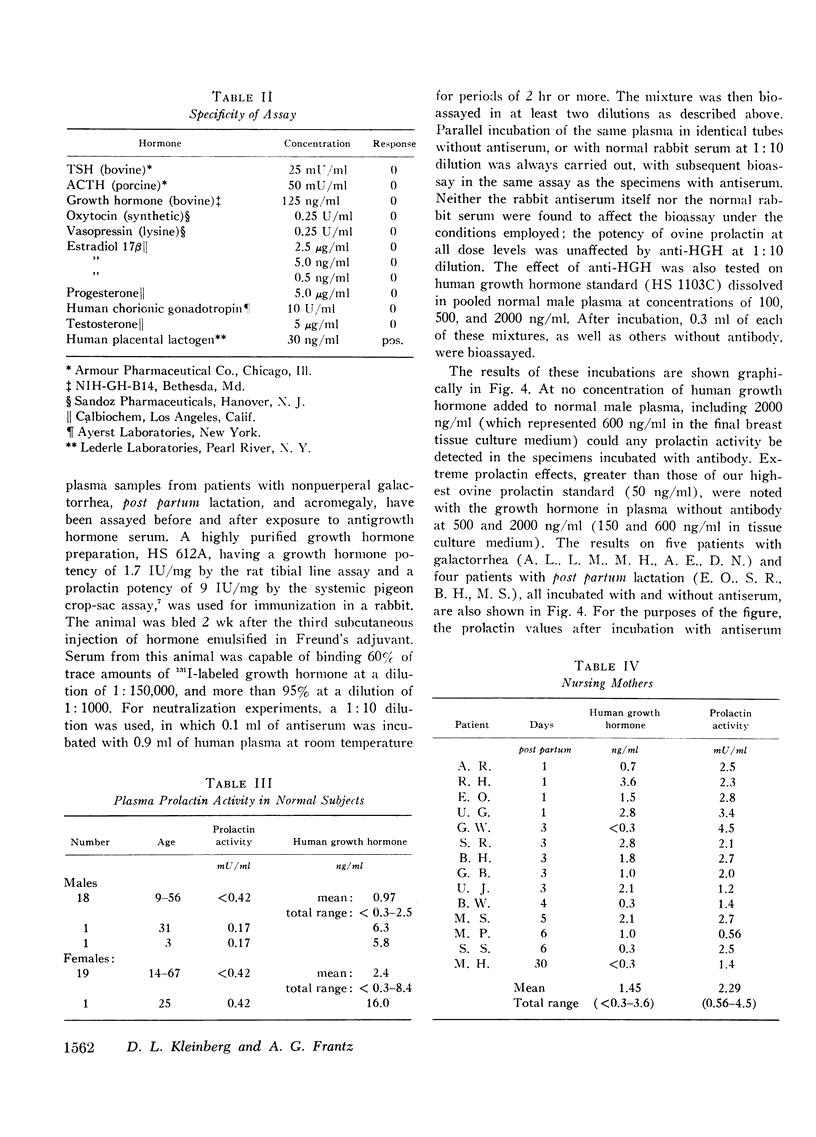
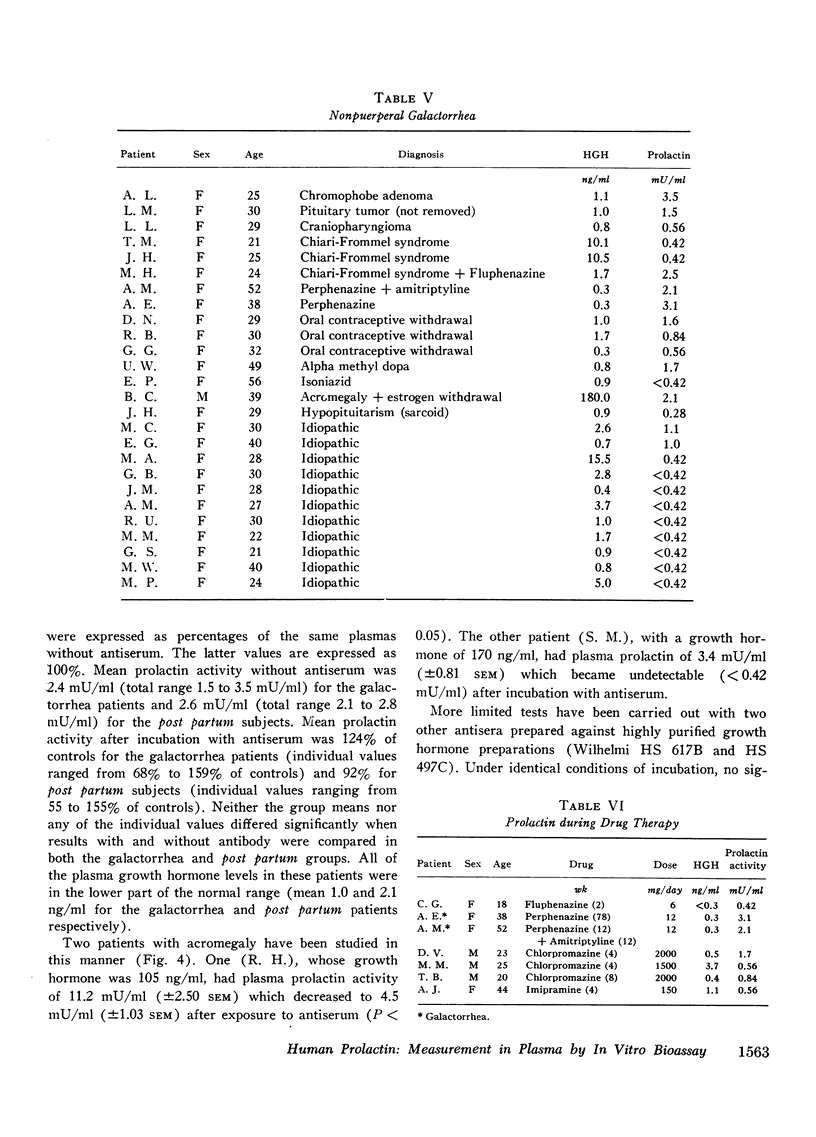
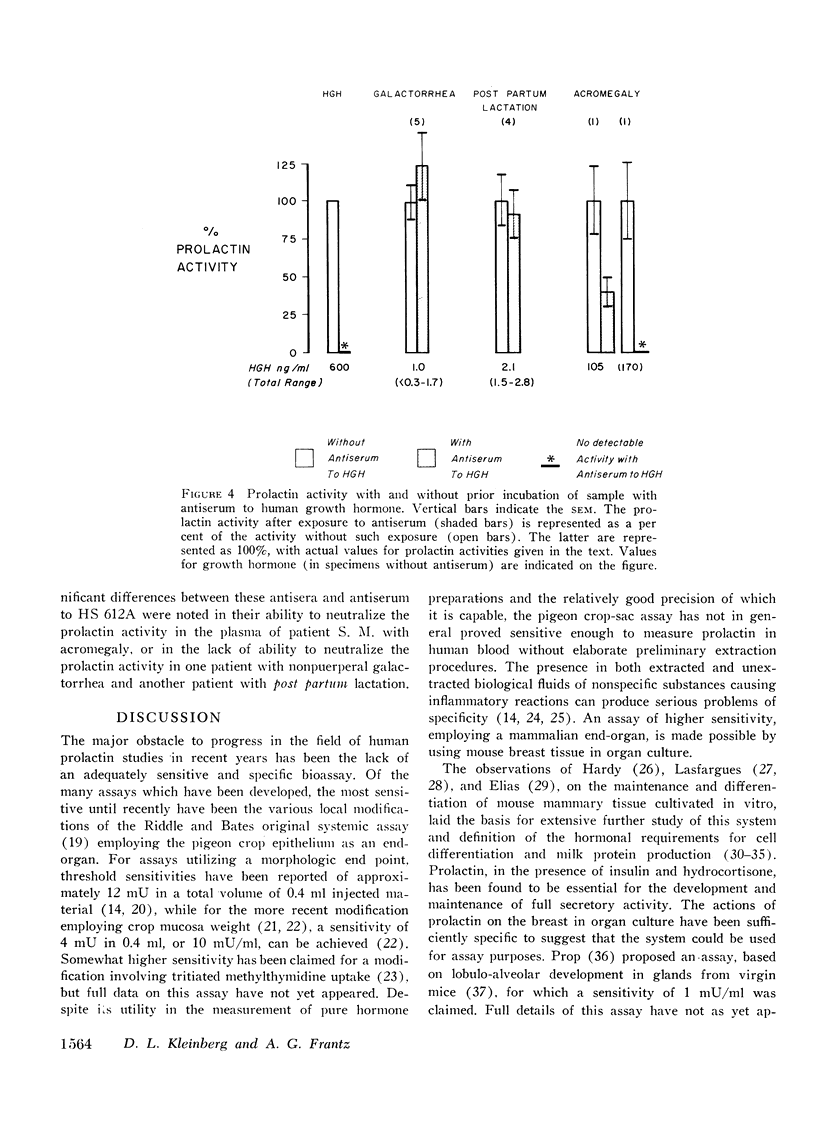
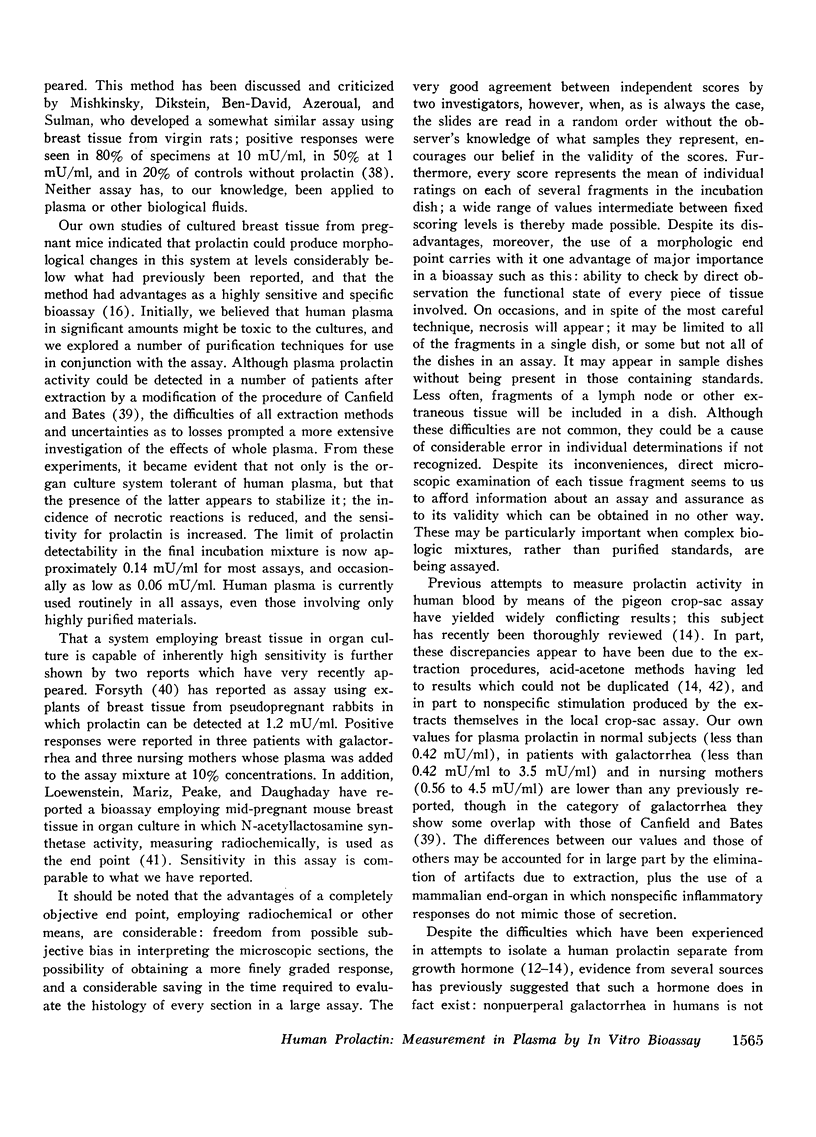
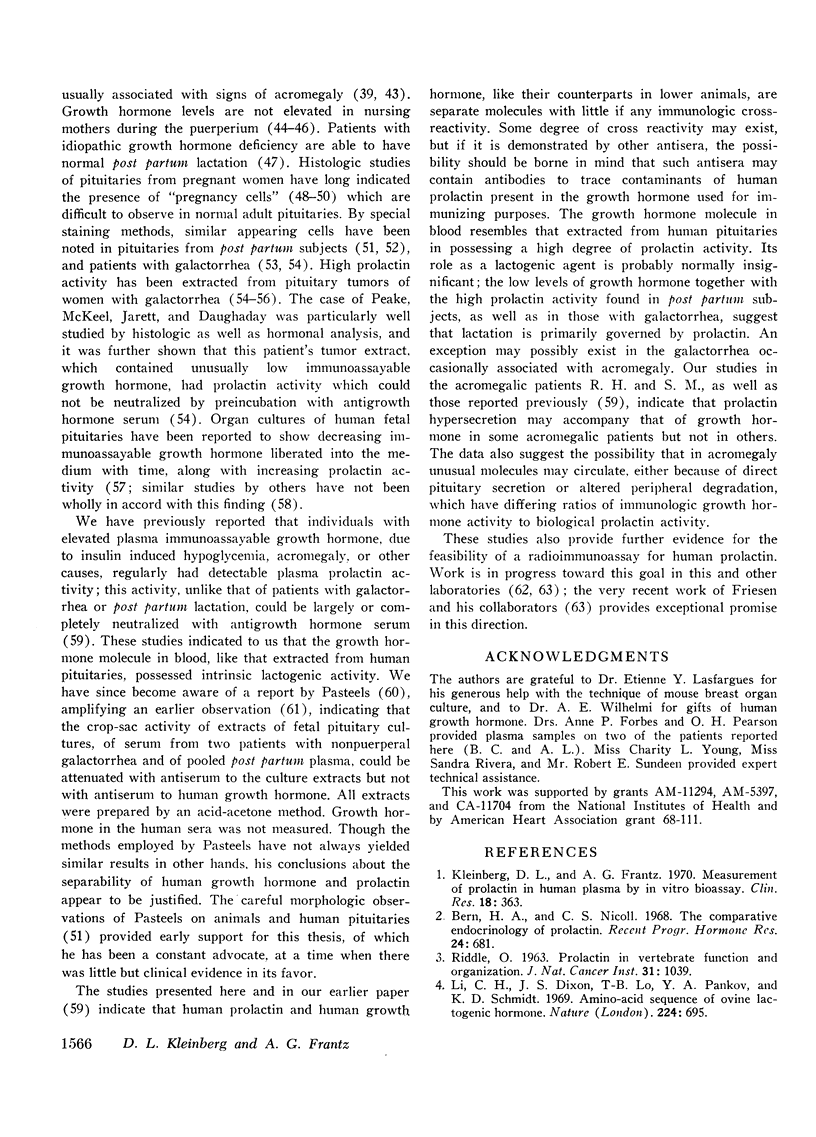


Images in this article
Selected References
These references are in PubMed. This may not be the complete list of references from this article.
- Arai Y., Lee T. H. A double-antibody radioimmunoassay procedure for ovine pituitary prolactin. Endocrinology. 1967 Nov;81(5):1041–1046. doi: 10.1210/endo-81-5-1041. [DOI] [PubMed] [Google Scholar]
- BAHN R. C., BATES R. W. Histologic criteria for detection of prolactin: lack of prolactin in blood and urine of human subjects. J Clin Endocrinol Metab. 1956 Oct;16(10):1337–1346. doi: 10.1210/jcem-16-10-1337. [DOI] [PubMed] [Google Scholar]
- BRAUMAN J., BRAUMAN H., PASTEELS J. L. IMMUNOASSAY OF GROWTH HORMONE IN CULTURES OF HUMAN HYPOPHYSIS BY THE METHOD OF COMPLEMENT FIXATION: COMPARISON OF THE GROWTH HORMONE SECRETION AND THE PROLACTIN ACTIVITY. Nature. 1964 Jun 13;202:1116–1118. doi: 10.1038/2021116a0. [DOI] [PubMed] [Google Scholar]
- Ben-David M. A sensitive bioassay for prolactin based on H3-methyl-thymidine uptake by the pigeon-crop mucous epithelium. Proc Soc Exp Biol Med. 1967 Jul;125(3):705–708. doi: 10.3181/00379727-125-32185. [DOI] [PubMed] [Google Scholar]
- Bern H. A., Nicoll C. S. The comparative endocrinology of prolactin. Recent Prog Horm Res. 1968;24:681–720. doi: 10.1016/b978-1-4831-9827-9.50019-8. [DOI] [PubMed] [Google Scholar]
- Bewley T. A., Li C. H. Primary structures of human pituitary growth hormone and sheep pituitary lactogenic hormone compared. Science. 1970 Jun 12;168(3937):1361–1362. doi: 10.1126/science.168.3937.1361. [DOI] [PubMed] [Google Scholar]
- Bryant G. D., Greenwood F. C. Radioimmunoassay for ovine, caprine and bovine prolactin in plasma and tissue extracts. Biochem J. 1968 Oct;109(5):831–840. doi: 10.1042/bj1090831. [DOI] [PMC free article] [PubMed] [Google Scholar]
- CHADWICK A., FOLLEY S. J., GEMZELL C. A. Lactogenic activity of human pituitary growth hormone. Lancet. 1961 Jul 29;2(7196):241–243. doi: 10.1016/s0140-6736(61)90359-2. [DOI] [PubMed] [Google Scholar]
- Canfield C. J., Bates R. W. Nonpuerperal galactorrhea. N Engl J Med. 1965 Oct 21;273(17):897–902. doi: 10.1056/NEJM196510212731703. [DOI] [PubMed] [Google Scholar]
- ELIAS J. J. Cultivation of adult mouse mammary gland in hormone-enriched synthetic medium. Science. 1957 Oct 25;126(3278):842–843. doi: 10.1126/science.126.3278.842-a. [DOI] [PubMed] [Google Scholar]
- FERGUSON K. A., WALLACE A. L. Prolactin activity of human growth hormone. Nature. 1961 May 13;190:632–633. doi: 10.1038/190632a0. [DOI] [PubMed] [Google Scholar]
- FLODERUS S. Changes in the human hypophysis in connection with pregnancy. Acta Anat (Basel) 1949;8(4):329–346. doi: 10.1159/000140421. [DOI] [PubMed] [Google Scholar]
- FORBES A. P., HENNEMAN P. H., GRISWOLD G. C., ALBRIGHT F. Syndrome characterized by galactorrhea, amenorrhea and low urinary FSH: comparison with acromegaly and normal lactation. J Clin Endocrinol Metab. 1954 Mar;14(3):265–271. doi: 10.1210/jcem-14-3-265. [DOI] [PubMed] [Google Scholar]
- FORSYTH I. A., FOLLEY S. J., CHADWICK A. LACTOGENIC AND PIGEON CROP-STIMULATING ACTIVITIES OF HUMAN PITUITARY GROWTH HORMONE PREPARATIONS. J Endocrinol. 1965 Jan;31:115–126. doi: 10.1677/joe.0.0310115. [DOI] [PubMed] [Google Scholar]
- FRANTZ A. G., RABKIN M. T. HUMAN GROWTH HORMONE. CLINICAL MEASUREMENT, RESPONSE TO HYPOGLYCEMIA AND SUPPRESSION BY CORTICOSTEROIDS. N Engl J Med. 1964 Dec 31;271:1375–1381. doi: 10.1056/NEJM196412312712701. [DOI] [PubMed] [Google Scholar]
- Forsyth I. A. The detection of lactogenic activity in human blood by bioassay. J Endocrinol. 1970 Feb;46(2):iv–v. [PubMed] [Google Scholar]
- Frantz A. G., Kleinberg D. L. Prolactin: evidence that it is separate from growth hormone in human blood. Science. 1970 Nov 13;170(3959):745–747. doi: 10.1126/science.170.3959.745. [DOI] [PubMed] [Google Scholar]
- Friesen H., Guyda H., Hardy J. The biosynthesis of human growth hormone and prolactin. J Clin Endocrinol Metab. 1970 Dec;31(6):611–624. doi: 10.1210/jcem-31-6-611. [DOI] [PubMed] [Google Scholar]
- GROSVENOR C. E., TURNER C. W. Assay of lactogenic hormone. Endocrinology. 1958 Nov;63(5):530–534. doi: 10.1210/endo-63-5-530. [DOI] [PubMed] [Google Scholar]
- Goluboff L. G., Ezrin C. Effect of pregnancy on the somatotroph and the prolactin cell of the human adenohypophysis. J Clin Endocrinol Metab. 1969 Dec;29(12):1533–1538. doi: 10.1210/jcem-29-12-1533. [DOI] [PubMed] [Google Scholar]
- HARDY M. H. The development in vitro of the mammary glands of the mouse. J Anat. 1950 Oct;84(4):388–393. [PMC free article] [PubMed] [Google Scholar]
- Juergens W. G., Stockdale F. E., Topper Y. J., Elias J. J. Hormone-dependent differentiation of mammary gland in vitro. Proc Natl Acad Sci U S A. 1965 Aug;54(2):629–634. doi: 10.1073/pnas.54.2.629. [DOI] [PMC free article] [PubMed] [Google Scholar]
- KANEMATSU S., SAWYER C. H. Effects of intrahypothalamic and intrahypophysial estrogen implants on pituitary prolactin and lactation in the rabbit. Endocrinology. 1963 Feb;72:243–252. doi: 10.1210/endo-72-2-243. [DOI] [PubMed] [Google Scholar]
- Katz H. P., Grumbach M. M., Kaplan S. L. Diminished growth hormone response to arginine in the puerperium. J Clin Endocrinol Metab. 1969 Nov;29(11):1414–1419. doi: 10.1210/jcem-29-11-1414. [DOI] [PubMed] [Google Scholar]
- Kwa H. G., Verhofstad F. Radioimmunoassay of rat prolactin. Biochim Biophys Acta. 1967 Jan 18;133(1):186–188. doi: 10.1016/0005-2795(67)90057-8. [DOI] [PubMed] [Google Scholar]
- LASFARGUES E. Y. Cultivation and behavior in vitro of the normal mammary epithelium of the adult mouse. II. Observations on the secretory activity. Exp Cell Res. 1957 Dec;13(3):553–562. doi: 10.1016/0014-4827(57)90085-x. [DOI] [PubMed] [Google Scholar]
- Meites J., Nicoll C. S. Adenohypophysis:prolactin. Annu Rev Physiol. 1966;28:57–88. doi: 10.1146/annurev.ph.28.030166.000421. [DOI] [PubMed] [Google Scholar]
- Mishkinsky J., Dikstein S., Ben-David M., Azeroual J., Sulman F. G. A sensitive in vitro method for prolactin determination. Proc Soc Exp Biol Med. 1967 Jun;125(2):360–363. doi: 10.3181/00379727-125-32091. [DOI] [PubMed] [Google Scholar]
- Nicoll C. S. Bio-assay of prolactin. Analysis of the pigeon crop-sac response to local prolactin injection by an objective and quantitative method. Endocrinology. 1967 Apr;80(4):641–655. doi: 10.1210/endo-80-4-641. [DOI] [PubMed] [Google Scholar]
- Niswender G. D., Chen C. L., Midgley A. R., Jr, Meites J., Ellis S. Radioimmunoassay for rat prolactin. Proc Soc Exp Biol Med. 1969 Mar;130(3):793–797. doi: 10.3181/00379727-130-33657. [DOI] [PubMed] [Google Scholar]
- PASTEELS J. L. RECHERCHES MORPHOLOGIQUES ET EXP'ERIMENTALES SUR LA S'ECR'ETION DE PROLACTINE. Arch Biol (Liege) 1963;74:439–553. [PubMed] [Google Scholar]
- PROP F. J. Sensitivity to prolactin of mouse mammary glands in vitro. Exp Cell Res. 1961 Sep;24:629–631. doi: 10.1016/0014-4827(61)90473-6. [DOI] [PubMed] [Google Scholar]
- Pasteels J. L., Brauman H., Brauman J. Comparaison de propriétes immunologiques de la somatotrophine et de la prolactine humaines. C R Acad Sci Hebd Seances Acad Sci D. 1965 Aug 18;261(7):1746–1748. [PubMed] [Google Scholar]
- Pasteels J. L. Hormone de croissance et prolactine dans l'hypophyse humaine. Ann Endocrinol (Paris) 1967 Jan-Feb;28(1):117–126. [PubMed] [Google Scholar]
- Peake G. T., McKeel D. W., Jarett L., Daughaday W. H. Ultrastructural, histologic and hormonal characterization of a prolactin-rich human pituitary tumor. J Clin Endocrinol Metab. 1969 Nov;29(11):1383–1393. doi: 10.1210/jcem-29-11-1383. [DOI] [PubMed] [Google Scholar]
- RIDDLE O. PROLACTIN IN VERTEBRATE FUNCTION AND ORGANIZATION. J Natl Cancer Inst. 1963 Nov;31:1039–1110. [PubMed] [Google Scholar]
- RIVERA E. M., BERN H. A. Influence of insulin on maintenance and secretory stimulation of mouse mammary tissues by hormones in organ-culture. Endocrinology. 1961 Aug;69:340–353. doi: 10.1210/endo-69-2-340. [DOI] [PubMed] [Google Scholar]
- RIVERA E. M. DIFFERENTIAL RESPONSIVENESS TO HORMONES OF C3H AND A MOUSE MAMMARY TISSUES IN ORGAN CULTURE. Endocrinology. 1964 Jun;74:853–864. doi: 10.1210/endo-74-6-853. [DOI] [PubMed] [Google Scholar]
- Rimoin D. L., Holzman G. B., Merimee T. J., Rabinowitz D., Barnes A. C., Tyson J. E., McKusick V. A. Lactation in the absence of human growth hormone. J Clin Endocrinol Metab. 1968 Aug;28(8):1183–1188. doi: 10.1210/jcem-28-8-1183. [DOI] [PubMed] [Google Scholar]
- Solomon I. L., Grant D. B., Burr I. M., Kaplan S. L., Grumbach M. M. Correlation between immunoreactive growth hormone and prolactin activity in human and simian pituitary cell cultures. Proc Soc Exp Biol Med. 1969 Nov;132(2):505–508. doi: 10.3181/00379727-132-34247. [DOI] [PubMed] [Google Scholar]
- Takatani O., Kumaoka S., Sakauchi N., Kuwahara T., Matsushima S. A case report of pituitary tumor presenting as Forbes-Albright syndrome: determination of pituitary prolactin content. Endocrinol Jpn. 1967 Jun;14(2):95–100. doi: 10.1507/endocrj1954.14.95. [DOI] [PubMed] [Google Scholar]
- Tashjian A. H., Jr, Levine L., Wilhelmi A. E. Immunochemical studies with antisera to fractions of human growth hormone which are high or low in pigeon crop gland-stimulating activity. Endocrinology. 1965 Dec;77(6):1023–1036. doi: 10.1210/endo-77-6-1023. [DOI] [PubMed] [Google Scholar]
- Topper Y. J. Multiple hormone interactions related to the growth and differentiation of mammary gland in vitro. Trans N Y Acad Sci. 1968 Apr;30(6):869–874. doi: 10.1111/j.2164-0947.1968.tb02530.x. [DOI] [PubMed] [Google Scholar]
- Turkington R. W., Brew K., Vanaman T. C., Hill R. L. The hormonal control of lactose synthetase in the developing mouse mammary gland. J Biol Chem. 1968 Jun 25;243(12):3382–3387. [PubMed] [Google Scholar]
- Turkington R. W., Topper Y. J. Androgen inhibition of mammary gland differentiation in vitro. Endocrinology. 1967 Feb;80(2):329–336. doi: 10.1210/endo-80-2-329. [DOI] [PubMed] [Google Scholar]
- Tyson J. E., Rabinowitz D., Merimee T. J., Friesen H. Response of plasma insulin and human growth hormone to arginine in pregnant and postpartum females. Am J Obstet Gynecol. 1969 Feb 1;103(3):313–319. doi: 10.1016/0002-9378(69)90488-8. [DOI] [PubMed] [Google Scholar]
- WILHELMI A. E. Fractionation of human pituitary glands. Can J Biochem Physiol. 1961 Nov;39:1659–1668. doi: 10.1139/o61-183. [DOI] [PubMed] [Google Scholar]




